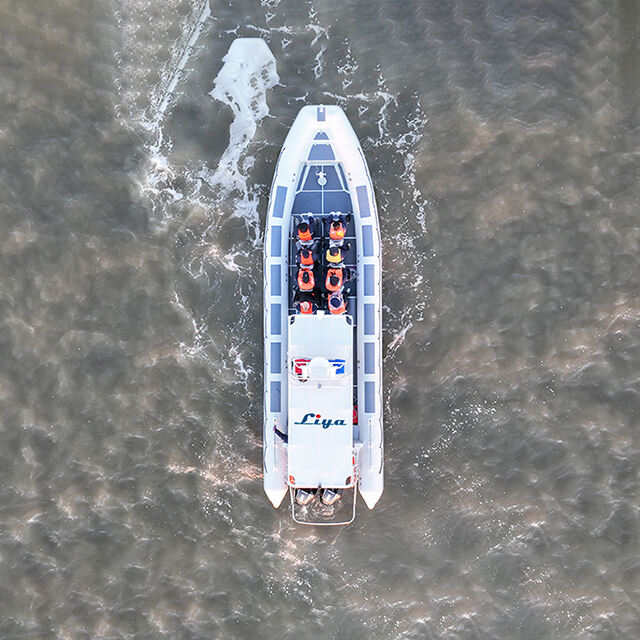Njohja me Botën e Anijeve me Hull Rigide të Fryrë
Anijet me Hull Rigide të Fryrë, të njohura zakonisht si RHIBs , përfaqësojnë bashkimin perfekt të performancës, shumëanshëmërisë dhe sigurisë në ujë. Pavarësisht se a jeni një profesional në detari, operator shpëtimi apo një amator i lundrimit, gjetja e RHIB-së së duhur për shitje kërkon konsideratë të kujdesëshme të disa faktorëve. Këto anije të veçanta kombinojnë një hull të fortë me gypa të fryrë, duke ofruar stabilitet dhe besueshmëri të jashtëzakonshme në kushte të ndryshme.
Tregu i RHIB-ve ka evoluar në mënyrë të konsiderueshme gjatë viteve të fundit, me prodhues që prezantojnë veçori inovative dhe dizajne të përmirësuara për të plotësuar kërkesat e ndryshme të përdoruesve. Nga modele të kompaktuara ideale për aktivitete të lira deri në anije në shkallë të madhe të përshtatshme për operacione komerciale, opsionet janë të gjera. Njohja e aspekteve kyçe të zgjedhjes së RHIB-it do të sigurojë që të bëni një investim të informuar që përputhet me nevojat tuaja specifike.
Veçoritë themelore që duhet të konsiderohen gjatë blerjes së një RHIB-i
Dizajni i Pajisjes dhe Materialet e Ndërtimit
Baza e çdo rHIB-je cilësore qëndron në dizajnin e pajisjes dhe materialet e ndërtimit. RHIB-të e sotëm tipikisht kanë pajisje prej fiberglasi, alumini apo kompozitësh, ku secila ofron veçori të veçanta. Pajisjet prej fiberglasi ofrojnë qëndrueshmëri të shkëlqyer dhe udhëtim të lëmuar, ndërsa ndërtimi me alumini ofron qëndrueshmëri të jashtëzakonshme ndaj goditjeve dhe peshë më të lehtë. Zgjedhja e materialit të pajisjes ndikon në mënyrë të konsiderueshme në performancën e anijes, kërkesat për mirëmbajtje dhe jetën e saj të gjatë.
Kur vështroni një RHIB për shitje, kushtoni kujdes të veçantë në dizajnin e thellë-V të përgjithshëm, i cili ndikon në mënyrë të drejtpërdrejtë në menaxhimin e ujërave të rënda. Një gjashtë e dizajnuar mirë me formë të thellë-V pret në mënyrë efikase valët, duke siguruar një udhëtim më të komod dhe karakteristika më të mira në kushte të vështira. Cilësia e bashkimeve të ndërtimit, e përfundimit dhe e përgjithshme e punës duhet të vështrrohet me kujdes, pasi këto elemente ndikojnë drejtpërdrejt në besueshmërinë e gjatë të anijes.
Konfigurimi i Tubave dhe Cilësia e Materialeve
Tubat e fryrë që karakterizojnë RHIB-të luajnë një rol kyç në stabilitetin dhe sigurinë. Tubat me cilësi të lartë janë të bërë zakonisht nga materiale të forta si Hypalon ose PVC, të projektuara për të qëndruar në ambientet e ashpra marine dhe ekspozim UV. Kur vlerësoni një RHIB për shitje, kontrolloni trashësinë e materialit të tubave, konstruksionin e skajeve dhe numrin e kamerave të ajrit të veçanta – kamerat e shumëfishta ofrojnë redundancë të rëndësishme për sigurinë.
Dizajnet e tubave moderne shpesh përfshijnë veçori inovative si profile në formë D-je për performancë të përmirësuar dhe hapësirë të brendshme më të madhe. Metoda e montimit të tubit në trupin e anijes është një tjetër konsideratë e rëndësishme, pasi ndikon në integritetin e anijes dhe nevojat për mirëmbajtje. Kërkoni sisteme montimi të qëndrueshme që garantojnë qëndrueshmërinë në të ardhmen, por që lejojnë edhe zëvendësimin e tubit nëse është e nevojshme.

Konsiderata për Performancë dhe Fuqi
Zgjedhja dhe Konfigurimi i Motorrit
Zgjedhja e sistemit të përparmës ndikon në aftësitë dhe kostot operative të një RHIB-e. Shumica e RHIB-ve pranojnë motorë të jashtëm, megjithatë disa modele më të mëdha mund të kenë sisteme me motor të brendshëm apo me pompë uji. Kur shfletoni nëpër listat e RHIB-ve në shitje, konsideroni fuqinë maksimale të motorrit dhe nëse konfigurimi me një apo dy motorë është më i përshtatshëm për nevojat tuaja. Disa motorë ofrojnë redundancë dhe fuqi shtesë, por rrisin edhe kostot fillestare dhe ato të mirëmbajtjes.
Eficienca e karburantit, besueshmëria dhe disponueshmëria e shërbimit duhet të merren parasysh gjatë zgjedhjes së motorit. Motorët modernë katërçykthë ofrojnë ekonomi të shkëlqyeshme të karburantit dhe ulje të emetimit në krahasim me modelet më të vjetra dyçykthë. Pesha e motorit ndikon gjithashtu në performancën dhe karakteristikat e drejtimit të anijes, duke bërë të nevojshëm arritjen e ekuilibrit të duhur për përdorimin që keni parashikuar.
Shpejtësia dhe Karakteristikat e Drejtimit
Anijet RHIB njihen për kapacitetet e tyre të shkëlqyeshme performuese, por modelet e ndryshme kanë karakteristika të drejtimit të ndryshme. Mërini parasysh përdorimin e planifikuar – nëse është për ndjekje me shpejtësi të lartë, lundrim të këndshëm apo bartje të ngarkesave të rënda – sepse kjo do të përcaktojë profilin optimal të performancës. Marrëdhënia midis dizajnit të trupit, daljes së fuqisë dhe shpërndarjes së peshës ka ndikim të madh mbi mënyrën se si anija drejtohet në kushte të ndryshme.
Kur të testoni një RHIB për shitje, vlerësoni nxitimin e saj, rrezen e kthimit dhe stabilitetin në shpejtësi të ndryshme. Anija duhet të mbajë aftësinë e saj të lëvizjes në kushte të rënda, duke ofruar një udhëtim të komod. Mbani mend se sa mirë që ajo rrit shpejtësinë dhe sjelljen e saj në kthesa të ngushta, pasi këto karakteristika ndikojnë në sigurinë dhe efikasitetin operativ.
Konsiderata për Sigurinë dhe Ekipamentin
Karakteristikat Themelore të Sigurisë
Kërkesat për pajisjet e sigurisë ndryshojnë në varësi të përdorimit të kërkuar dhe të rregullave lokale, por disa karakteristika duhet të jenë standarde në çdo RHIB që është në shitje. Kërkoni vijë të kapjes së mirë dizajnuara, sipërfaqe jo të rrëshqitshme në pallë, dhe hapësirë të mjaftueshme për ruajtjen e pajisjeve të sigurisë. Dizajni i konsolës duhet të ofrojë pamje të qartë dhe qasje të lehtë në kontrolla dhe instrumente lundrimi. Pikat e montimit të pajisjeve të emergjencës dhe zonat e sigurta të ruajtjes për jaketë të jetës dhe pajisje të tjera të sigurisë janë konsiderata të rëndësishme.
RHIB-të modernë shpesh përfshijnë veçori të sigurisë të përparuara si pompë të ujit të brendshme automatike, llëngje lundrimi dhe çelësa të sigurisë për raste të jashtëzakonshme. Sistemi elektrik duhet të jetë i klasës marine dhe mirë i mbrojtur nga depërtimi i ujit. Konsideroni veçori shtesë të sigurisë si pasqyrat radar, instalimet e radios VHF dhe pajisjet e pozicionit të emergjencës radio (EPIRB) në varësi të përdorimit që keni parashikuar.
Lundrimi dhe Elektronika
RHIB-të bashkëkohore mund të pranojnë pajisje lundrimi dhe komunikimi të sofistikuara. Kur vlerësoni një RHIB për shitje, vlerësoni kapacitetin e panelit për të mbajtur pajisjet elektronike esenciale dhe sigurojini mbrojtjen e duhur nga moti. Kërkesat bazë përfshijnë zakonisht sisteme GPS/chartplotter, pajisje matëse të thellësisë së ujit dhe radio VHF. Sistemi elektrik duhet të mbështesë nevojat nga pajisjet e tanishme, por të lejojë edhe për mirëmbajtje të ardhshme.
Merrni parasysh integrimin e shumë sistemeve dhe të arritshmerinë e tyre gjatë funksionimit. Ekranet me prekje moderne ofrojnë menaxhim të informacionit të plotë, por matësit analoqë tradicional ofrojnë opsione të sigurta rezervë. Vendosja e pajisjeve elektronike duhet të lejojë pamje të qartë, ndërkohë që minimizon shkëlqimin dhe ruhen nga avulli dhe moti.
Konsiderata për Mirëmbajtjen dhe Pronësinë e Gjatë
Kërkesat e Mirëmbajtjes së Rregullt
Njohja e kërkesave për mirëmbajtje të një RHIB-je është e rëndësishme për të siguruar kënaqësinë në të ardhmen dhe mbajtjen e vlerës së saj. Detyrat e rregullta të mirëmbajtjes përfshijnë mbikëqyrjen e shtypjes së gomës, pastrimin e anës së poshtme, mirëmbajtjen e motorrit dhe inspektimin e pajisjeve mekanike. Kur konsideroni blerjen e një RHIB-je, hetoni disponueshmërinë e pjesëve të këmbimit dhe furnitorëve të kualifikuar të shërbimit në zonën tuaj. Dokumentacioni i duhur i mirëmbajtjes dhe historiku i shërbimeve janë tregues të vlefshëm të një anije të mirëmbajtur.
Vendosni një plan mirëmbajtjeje të plotë që përfshin kontrolla të rregullta dhe pastrime të thella periodike. Kushtoni vëmendje të veçantë për kujdesin e gypave, duke përfshirë pastrimin e duhur, mbrojtjen nga rrezet UV dhe menaxhimin e shtypjes. Mirëmbajtja e përditshme e trupit të anijes, duke përfshirë trajtimet antifouling kur është e nevojshme, ndihmon në ruajtjen e performancës dhe pamjes së saj.
Zgjidhje për Ruajtjen dhe Transportin
Aftësitë e ruajtjes dhe transportit kanë një ndikim të madh në përvojën e posedimit. Mendoni nëse do t'ju duhet një rimorkio dhe sigurohuni që ai të jetë i vlerësuar në mënyrë të duhur për peshën e anijes. Ruajtja brenda është ideale për të mbrojtur gypat nga dëmi i rrezeve UV dhe për të zgjatur jetën e tyre të shfrytëzimit. Kur shikoni një anije RHIB për shitje, verifikoni që zgjidhjet e ruajtjes të përfshira ose të kërkuara të jenë në përputhje me mundësitë tuaja të transportit dhe hapësirat për ruajtje.
Merrni parasysh faktorë të tillë si pikat e ngritjes për operacionet e kranit, dizajni i rimorkiosës për lëshim dhe rimarrje të lehtë dhe opsionet e mbulesave për ruajtje. Disa nga anijet RHIB kanë gypa të shkollueshëm apo dizajne modulare që e lehtësojnë ruajtjen në hapësira të kufizuara. Këto karakteristika mund të jenë veçanërisht të vlefshme për anije që përdoren në mënyrë sezionale apo në zona me mundësi të kufizuara për ruajtje.
Pyetje të Bëra Shpesh
Cila është jetëgjatësia tipike e gypave të fryrë të një RHIB-e?
Tubat cilësorë RHIB, kur mirëmbahen siç duhet, zakonisht zgjasin 8-12 vjet. Faktorët që ndikojnë në jetëgjatësi përfshijnë cilësinë e materialit, ekspozimin ndaj rrezeve UV, modelet e përdorimit dhe praktikat e mirëmbajtjes. Pastrimi i rregullt, mirëmbajtja e duhur e presionit dhe mbrojtja nga UV mund ta zgjasin ndjeshëm jetëgjatësinë e tubave.
Si i krahasojnë RHIB-et me anijet e forta tradicionale në kuptim të stabilitetit?
Zakonisht RHIB-t ofrojnë qëndrueshmëri më të lartë krahasuar me anijet e zakonshme të ngurta për shkak të dizajnit të gomës së fryrë. Gomat ofrojnë ngritje sekondare dhe qëndrueshmëri të shkëlqyeshme, veçanërisht në kushte të rënda ose gjatë manovrave me shpejtësi të lartë. Kjo strukturë ofron gjithashtu kapacitet më të lartë mbajtës dërrase dhe karakteristika të përmirësuara sigurie.
Çka duhet të jetë konsiderata kryesore gjatë përcaktimit të madhësisë së një RHIB-je?
Faktorët kryesorë në përcaktimin e madhësisë së RHIB-së përfshijnë përdorimin e konsideruar, numrin tipik të udhëtarëve, kapacitetin e kërkuar të ngarkesës dhe hapësirën e disponueshme të depozitimit. Merreni parasysh marrëdhënien midis gjatësisë, gjerësisë së anës dhe kërkesave për fuqi. Më i madhi nuk është gjithmonë më i miri – madhësia ideale ekuilibron performancën, efikasitetin dhe praktikësinë për nevojat tuaja specifike.
A janë të përshtatshme RHIB-të për udhëtim të gjatë?
Edhe pse Mëngëjet e tërësishme të fryrë (RHIBs) mund të pajisën për udhëtime të gjata, aftësia e tyre varet nga karakteristikat e projektimit dhe pajisjet. Faktorët që duhet të merren parasysh përfshijnë kapacitetin e karburantit, komoditetin e ulëseve, mbrojtjen nga moti dhe hapësirën e depozitimit. Shumë nga Mëngëjet RHIB të kohëve moderne ofrojnë autonomi dhe tipare komoditeti që i bëjnë ata anije të afta për udhëtime rekreative.

